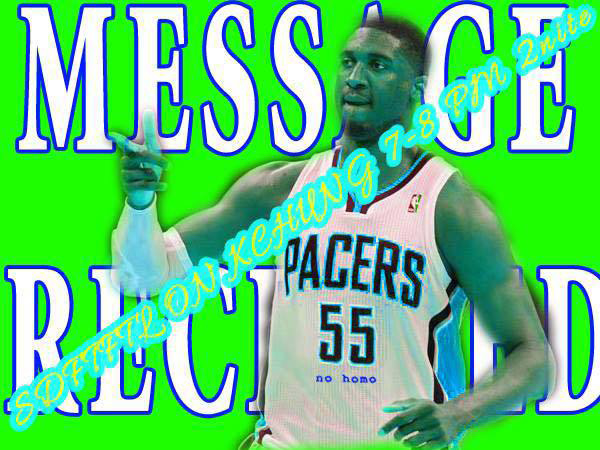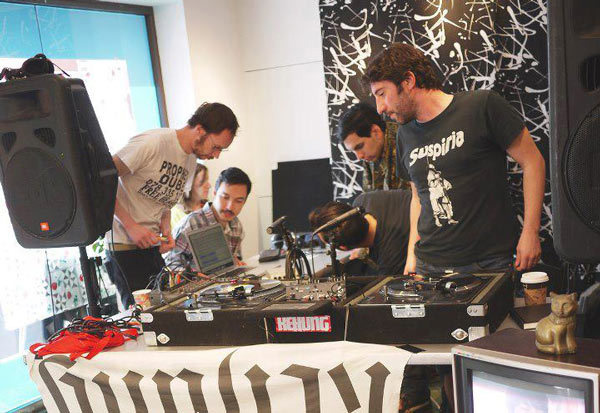Art on Air
by Kate Wolf

A flyer for Episode 26 of Lady C’s Slam Dunx from the Free Throw Line, aired on June 10, 2013.
Close Radio was a weekly artists’ program that ran from 1976 to 1979 on local station KPFK in Los Angeles. Originally conceived of by the artists John Duncan and Neil Goldstein—and later organized by Duncan, Paul McCarthy, Nancy Buchanan, and High Performance editor Linda Frye Burnham—the more than 100 Close Radio broadcasts included experimental sound art and exploratory conversation contributed by the likes of Guy de Cointet, Martha Rosler, Jack Goldstein, Carolee Schneemann, John Baldessari, and many others during the three years the program aired. The end of Close Radio came in the form of “Send Me Your Money,” a March 1979 broadcast in which Chris Burden only barely sidesteps FCC regulations by asking listeners to imagine sending him money, while repeating his address throughout the hour and reasoning, to very amusing affect, why he is deserving. For KPFK, Burden’s show crossed a line that had likely been tested numerous times before with shows like Barton Patrick Bolin’s eight minutes of “meditative” live silence or Richard Newton’s stand as Dr. Fang, who argued the value of a fart economy as a solution to the depletion of oil resources. After the broadcast of “Send Me Your Money,” the program was canceled for good.1
Still, Close Radio marked a high point in the convergence of Los Angeles’s then obscure performance and conceptual art scenes, and connected them with a larger audience. Based on conservative estimates given at the time by KPFK, the Wednesday broadcast averaged around 20,000 listeners, many of whom even called in to participate in the artists’ shows.2During a 2007 panel discussion about Close Radio arranged for the Getty Museum exhibition “Evidence of Movement,” Duncan posed a question to potential successors: “What happens [next]?” he asked. “That’s when it becomes interesting.”3
And by relatively any measure, what has happened next is KCHUNG 1630 AM, broadcasting out of Chinatown. Mainly artist run, with segments and shows hosted by Laura Owens, Brendan Fowler, Fiona Connor, Simon Leung, A.L. Steiner, and many more during the last two years, KCHUNG has become an outlet for art and experimentation on the airwaves in myriad forms; in a way not unlike Close Radio, its programs suggest the portrait of a vivacious community of artists currently working in Los Angeles, which the station is a product of.
That KCHUNG lacks KPFK’s wide-range antenna on the top of Mt. Wilson allows it even more freedom, if a fraction of the listeners Close Radio had. And although there’s something poetic and conceptually compelling about the idea of hyperlocalized radio, the reason for this was mostly logistical. Solomon Bothwell, one of KCHUNG’s founders (the others are Harsh Patel and Luke Fischbeck), had been inspired to start his own station, and with experience in college radio, some research into the FCC’s provision for unlicensed operators, and an autodidact’s approach to the technology, he did. KCHUNG began broadcasting live in summer 2011 at different nomadic events around Los Angeles—at places such as LACMA, The Smell, and Ooga Booga—with a hand-rigged portable antenna, the signal reaching only those who were also in attendance in the building or on the same floor. Soon afterward, Bothwell set up a low-powered transmitter in the basement of the Public School in Chinatown. With an antenna nearby atop Fischbeck’s studio, the station’s signal reached only about the 500-foot length of Chung King Road.
For its first six months, KCHUNG broadcast regularly about five hours a day, four days a week. Bothwell, who also works as a fabricator for artists and musicians, found himself in the basement of the Public School helping out almost every night. After nearly a year of this, amid complications with access to the space and other things, he felt overwhelmed. He drove to visit a friend in Mt. Shasta, and on his way back to Los Angeles, at the bottom of a winding, 40-mile stretch of I-5 known as the Grapevine, he stopped at a Starbucks and wrote to everyone on the KCHUNG email list. He needed things to change and wrote that if the station didn’t start to get some basic infrastructure and sense of shared responsibility, similar to that of any college radio station, it couldn’t continue.
At the time, KCHUNG had around 25 shows.
The email seems to have worked. About a year and a half later, KCHUNG now has a rotating schedule of 74 shows and a waiting list to host that’s even longer. The current broadcast, which averages around 30 hours a week, not including live events, is a mix of music, call-in, talk, and sound shows—often all of these wrapped into one—in addition to a range of more singular, concept-driven programming. On Yelena Zhelezov’s Tractor: Spoken Film Radio, for instance, the artist narrates over, translates, and discusses Soviet-era films. Stephen Van Dyck’s Customer Care is a collage of conversations he records with service agents and telemarketers, regularly leading them from the prosaic matters of accounting into more personal territory. Lady C’s Slam Dunx from the Free Throw Line consists of extended riffs on basketball set to music. Some programs are centered around reading texts out loud, such as Jack Heard’s The Reading Radio and a past show by Jordan Biren that was called simply Reading Blanchot; others focus on meditation and progressive spirituality, like Guru Rugu’s Experimental Meditation Hour!! with artist Adam Overton, or Jennifer Moon and Robert Watkins’s Adventures Within.4 An almost constant rotation of weekly live events—at places like The Last Bookstore or at MOCA Family Day or at a residency at Printed Matter’s Los Angeles Art Book Fair last January—includes reports from the “KCHUNG Newsteam,” interviews, and atmospheric transmissions. Perhaps, like with any radio station, the more one listens to the broadcasts, the more certain names begin to repeat, like Zen Mafia or Johnnie JungleGuts, radio personalities referencing one another in the growing universe that’s KCHUNG.

KCHUNG co-founder Solomon Bothwell (left) and friends broadcasting live from the MOCA bookstore on May 10, 2013.
This level of output is made possible by using a cooperative model to cover rent and other costs. Everyone with a show is asked to pay a small amount in dues each month, and there is now a growing volunteer staff that includes station managers during all broadcast hours, an accountant, a PR person, a communications director, a general manager, a music director, project managers for different live events, and so on. “It’s such a volunteer-based thing,” Bothwell says, “that there can’t be any expectations. Otherwise, somebody is going to get disappointed.”
But whether it’s the sheer novelty of radio and the hunger for it that existed before KCHUNG began, the eclecticism and autonomy granted to the staff and DJs, or simply the need for more outlets in Los Angeles that cater to performance-based practices, the station has generated enough enthusiasm to give it buoyancy, building exuberance and momentum in the way one might usually associate with an underground music club like The Smell or the oft-mythologized Jabberjaw. “This is different because it’s so diffuse,” Fischbeck says of the comparison. He adds, “I’m still interested in this sense of a precarious space. [KCHUNG] is safe in the sense that you’re not going to judged here or expelled—everybody’s welcome—but it’s also not safe in the sense that everyone feels like maybe they need to give a little bit more in order for it to continue or that it needs help somehow. It still feels like an infant, kind of.”
In addition to the airwaves, KCHUNG also streams live on the Internet and hosts an archive of all its shows, which is crucial to how most people hear it. However, its continuing gesture toward utilizing simple radio technology, in addition, makes KCHUNG more than just an Internet station, something that’s at once readily accessible, if still hermetic, online and elusive yet more public on air.
Last fall, the station was also able to secure a lease on a more permanent home. These days, if you climb the stairs of an inconspicuous office building over the Pho 87 Restaurant on Broadway—conveniently, it’s next to the great art and music venue Human Resources—and follow the trail of little pieces of blue tape stuck to the wall, you’ll find KCHUNG in the new studio it has been broadcasting from since last October. I did this on a recent Monday evening during the summer. I was greeted by an insanely large PA system and four black-metal bands, including the mysterious act Volahn, from Long Beach, setting up to perform an in-studio set on the program CDS Digest at 9 p.m.
Amid the chaos of the bands and their gear, a few onlookers were lighting candles to set the mood; others hung out on the building’s adjoining roof, a view of downtown’s lights in the distance. I waved to the artists John Burtle and Guan Rong, who, along with Bothwell, keep their own studios in the new space. They were recording their show, Noooooooooooooooooooooo, behind the glass as I arrived. I motioned to come in, they nodded yes, and suddenly I was a guest on the show. We discussed our most compatible astrological signs, among other things. I looked around the recording space as we talked. Flyers for past KCHUNG events hung on the walls, along with a sign made of glitter and stickers that said, “You Are Enough.” There was a station wish list for physical items and work to be done, notices for upcoming meetings and events, and a hand-drawn KCHUNG banner that hung above piles of equipment, a small music collection, and a stand of mixtapes for sale. When Volahn started playing a little later in the main space, the music was so heavy that, scared, I stayed behind the glass for cover. After a while, though, I went out and watched the slightly improbable scene, which was pretty incredible—a full-on metal show with stadium-sized sound being recorded in this compact space with low ceilings, a handful of people watching, and probably just a few more listening online. The band finished playing, another started, and eventually I left.
Outside it was quiet until I reached my car, parked across from the station’s rooftop, and heard again the blasting coming from within. In the moment, it seemed exciting to picture a day when anyone anywhere in Los Angeles might also be listening to these bands on the radio at the same time I was overhearing them on street, a time when KCHUNG would broadcast live 24 hours a day. KCHUNG does have plans to expand their airtime and signal, possibly by using a network of people who would transmit from online to air all over the city. But for now, just hearing them at all, whether online, on-air in a few precious spots in Chinatown, or, like I was then, from the street just outside the station, seems something to be grateful for as well.